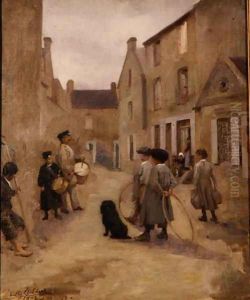Milly Childers Paintings
Emily 'Milly' Maria Eardley Childers, known as Milly Childers, was an English artist born on May 25, 1866, in London. She was the daughter of Hugh Culling Eardley Childers, a British Liberal statesman, and his second wife, Katherine Anne Gilbert. Milly was one of seven children in her family and was exposed to a culturally rich environment from a young age, which likely nurtured her artistic talents.
Milly Childers was educated at home, which was common for girls of her social class during the Victorian era. Despite the limitations often placed on women in the arts, she pursued her passion for painting. She specialized mainly in watercolors and is known for her landscapes and interior scenes, which were expertly executed with a delicate touch and attention to detail.
In the late 19th and early 20th centuries, she traveled extensively throughout Europe, which greatly influenced her work. Her paintings often captured the essence of the places she visited, including scenes from Italy, France, and the Netherlands. Childers' works were exhibited at the Royal Academy and the Royal Watercolour Society, among other notable galleries, and she gained recognition during her lifetime as a talented watercolorist.
Milly Childers never married and lived most of her life with her family. She was also the sister of Erskine Childers, a notable Irish nationalist and author of the espionage novel 'The Riddle of the Sands.' Her family's political and literary connections may have further provided her with a broader perspective and enriched her subject matter as an artist.
She continued to paint throughout her life, and her artworks were well-received by both critics and the public. Tragically, Milly's life was cut short when she died on March 30, 1922, at the age of 55. Although she is not widely known today, Milly Childers contributed to the British art scene of her time, and her works remain a testament to her skill as a watercolorist and as a woman artist navigating the art world during a time when it was dominated by men.
